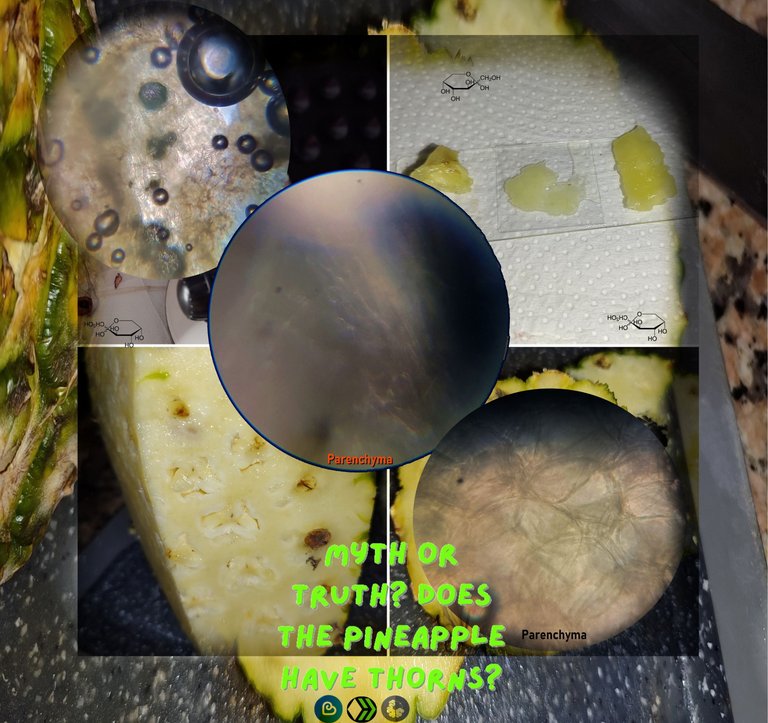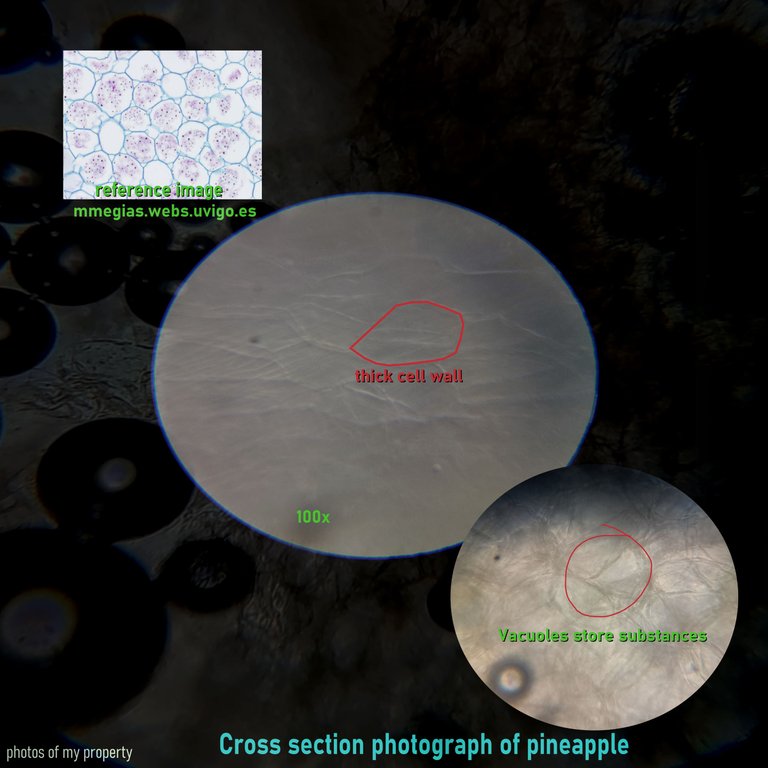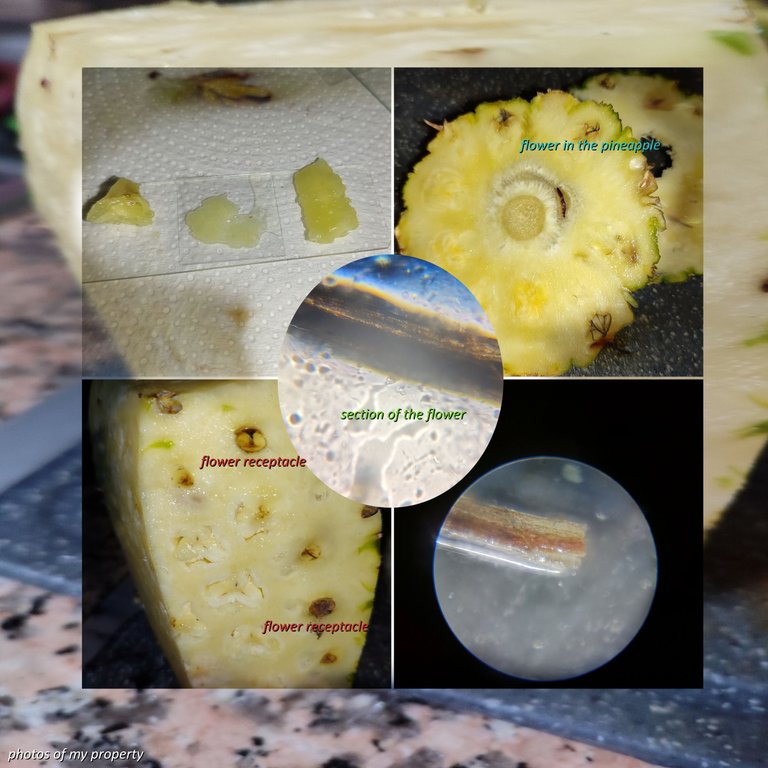Why Does Pineapple Sting the Tongue?🍍🔬
Sometimes when we eat pineapple we have a feeling of discomfort in our mouth, that is, as if the pineapple had something in its pulp that causes itching in the tongue. Have you ever been in that situation? When we look on the Internet we see many videos of "experiments" where they come to the conclusion that pineapple: "has some thorns" that cause the reaction to occur... Is that true? How about we do an experiment to show why pineapple causes that? Don't miss the experience.🤓🔬🍍

What is Parenchyma?🧫🔬🍍

To start and clarify all our doubts about this interesting topic we have to highlight that most of the tissue found in the fruit is parenchyma, almost all of it reserve parenchyma. I see that some references on the internet talk about an aquiferous parenchyma but this is more typical of roots and stems. Although it is advisable to also analyze a sample of the leaf, it seemed more relevant to go deeper into the fruit since the question to be answered is why does a pineapple sting the tongue? First of all we see very wide cells with thick walls, this is typical of reserve parenchyma cells! But what is parenchyma? Parenchyma is a living tissue that is quite metabolically active and is part of the fundamental tissues (parenchyma, chlorenchyma, sclerenchyma) (mmegias.webs.uvigo.es); This tissue is practically 90% of the flowering plant, and of course it has the role of performing many functions depending on where it is located.🔬🍍
https://mmegias.webs.uvigo.es/1-vegetal/guiada_v_parenquima.php

What are raphides?🧫🔬🍍

Here everything starts to make sense, how do I make a cross section of the fruit and get these needles? Is this the cause of the discomfort that pineapple sometimes causes? We get these "thorns" in the parenchyma tissue and they are called raphides, but what are they? In reality, they are "crystals" of calcium oxalate that serve as a defense mechanism against herbivorous animals, the way they act is by creating small "cuts" in the mucosa when chewed and then a compound acts... Which is responsible for producing the discomfort... (wiki/Rafidio), and it is there that bromelain comes into action, it is an enzyme that when it enters our body produces that itching effect! And so we manage to answer the big question! It is not the raphides that bother the fruit but the enzyme.🤓🔬🧪🧫
https://www.39ytu.com/expertos/beneficios-bromelaina

Another fact about the Parenchyma?🧫🔬🍍

Normally there is a vacuole which is a large cell that swells because it is "hydrated" and inside it the substances are stored within the parenchyma, the reserves can vary from water to lipids, including pigments; some cells manage to store only one substance while others can accumulate several substances. In this case the cell walls are thin and fragile (mmegias.webs.uvigo.es), if we look for other parts of the plant such as the stem or the leaf there we could find tannins and anthocyanins, this produces the color for example in the flowers. When it is winter, most of the reserve tissue is found in the stem, this to accumulate substance and be able to withstand the extreme winter climate.🤔🚩🧪🔬
https://www.sobreestoyaquello.com/2020/05/el-fascinante-interior-de-una-pina.html

Structure of pineapple🧫🔬🍍

To say that a pineapple is a fruit would be a botanical misnomer, since a fruit is a "mature ovule" while the pineapple in question is an inflorescence, that is, a group of flowers that grows on a main axis. This is called "sorosis" a division of several drupes growing together. Studying the pineapple is quite complex and it could be said that it is one of the most difficult fruits to explain in botany. Each "eye" ends up being where the plant has its flowers, and on the outside each structure corresponds to sepals that are false petals.
https://www.sobreestoyaquello.com/2020/05/el-fascinante-interior-de-una-pina.html

A view of the flower and cellular tissues🧫🔬🍍

Here we see a macrophotograph of the pineapple eyes. On the Internet we can find out what each part represents, for example the locules, the nectariferous ducts, the carpel, and of course the ovule, that is, this is where "fertilization" takes place. The center of the pineapple has another structure and is more rigid, I would say almost impossible to eat. It is called the (fibrovascular axis). The pineapple flower has a variety of colors in some cases, which are attractive to pollinators. There is a variety of excretory parenchyma that is responsible for reserving products that are "toxic" and are used as a defense mechanism, such as a corrosive white liquid in some plants.🤔🧫🤓🍍
https://www.sobreestoyaquello.com/2020/05/el-fascinante-interior-de-una-pina.html

THANKS FOR READING ME (PHOTOS AND VIDEOS OF MY PROPERTY) / GRACIAS POR LEERME FOTOS Y VIDEOS DE MI PROPIEDAD🙂🧠🦾👍
0
0
0.000
Pineapple, the "fruit" that eats you back!
Thanks for your contribution to the STEMsocial community. Feel free to join us on discord to get to know the rest of us!
Please consider delegating to the @stemsocial account (85% of the curation rewards are returned).
You may also include @stemsocial as a beneficiary of the rewards of this post to get a stronger support.